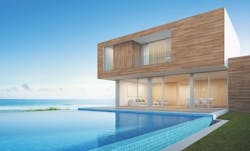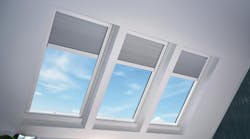Palmwood has been an available material for several decades for interior applications such as flooring and wall coverings. The material offers a unique look and characteristics, which make it ideal for modern applications and sustainably designed projects.
Palmwood recently became available for exterior cladding, and though the name may be deceiving, palmwood’s traits come from it not being an actual wood.
Origins
Palm is a monocot, or flowering plant, that grows “like a weed” in countries such as Pakistan, India, Thailand, and Cambodia, says Dan Smith, CEO/founder of Smith & Fong, a manufacturer of black palmwood products.
RELATED: 3 Materials That May Forever Change the Home’s Makeup
In the areas where it’s abundant, palmwood is a common building material. It can come from sugar palms or coconut trees, for example. Smith explains that sugar palms are often used as property dividers on rice paddies. Being a monocot also means palmwood does not grow outward like normal trees but grows upwards instead.
This results in a different composition and structure than commonly used woods because it lacks growth rings and the resulting wood grain. Instead, palmwood appears fibrous and features light and dark materials mixed, with light being cellulose and black being the dense fibers.
Harvesting
Smith & Fong uses sugar palms, and when harvested, these palms are upwards of 100 years old, 80 feet tall, and just a foot in diameter. At this point, nutrients have a hard time reaching the top of the palm’s stem, causing dead head, or a natural decapitation, explains Smith. The palm then becomes a stem, no longer capable of producing fruit.
Though harvested nearly a century after sprouting, there is no limit of inventory, explains Smith, because of how ubiquitous it is in its natural environment. This also makes palmwood products a naturally sustainable material, and Smith & Fong’s product is LEED credit-certified.
RELATED: 4 Ways to Get Customers to Buy Into Green Products
Palmwood has a pulpy, soft center, so the harvested wood comes from its extremely hard exterior. The material is highly resistant to moisture, working well in humid and wet climates. Black palm’s durability has been noted in its natural element, but Smith & Fong have put the material through rigorous testing at Oregon State University.
“We’re carving away all the soft material and retaining this material that is three times harder than oak,” explains Smith. “It’s extremely dense, extremely hard material. And it’s sort of impenetrable for powderpost beetles or termites or those sorts of things.”
Its hardness and density can be compared to Ipe, a rare South American wood with a fire rating similar to concrete and steel. The weight of black palm is also more than double that of a traditional timber such as oak.
Appearance
Smith says Smith & Fong products are well received in areas such as Florida, Texas, Arizona, New Mexico, and Hawaii—regions with similar climates to a natural palm environment. It’s also partly due to palm being an exotic material, making it appeal more strongly in certain markets.
“It would be appropriate for any environment, but more likely than not, I would expect it probably in an environment where that aesthetic would already have a natural acceptance and interest."




